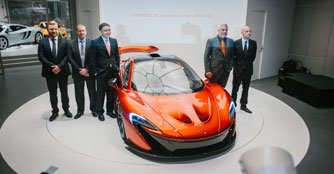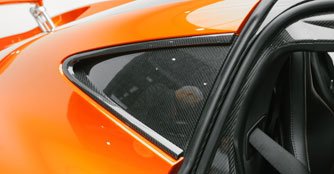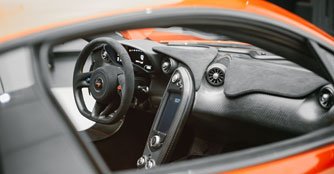South East Asian exclusive preview of the McLaren P1
08 Jul 2013|9,755 views
For the first time in Singapore and also in Southeast Asia, the McLaren P1 has been specially flown in for a preview and showcase to regional prospects, McLaren Singapore customers, media and other distinguished guests.

"McLaren introduced the carbon fibre chassis to the world of Formula One in 1981 with the MP4/1, and we had the first carbon-bodied road car. We have always been at the cutting edge of vehicle aerodynamics, and all of this experience has gone into the new McLaren P1. Twenty years ago, with the McLaren F1, we raised the supercar performance bar. With the McLaren P1, we have redefined it once more," said McLaren Automotive Executive Chairman Ron Dennis.
The astonishing new McLaren P1 has a clear goal - to be the best driver's car in the world on road and track. To achieve this objective, McLaren is using all of its 50 years of racing experience and success, especially in the fields of aerodynamics and lightweight carbon fibre technology.
The result is a car that has an unprecedented amount of downforce for a road vehicle: similar levels to a GT3 racing car and yet with even greater ground effect. This downforce not only boosts cornering and braking performance. It also helps balance, stability and driveability at all speeds.
The McLaren P1 uses an innovative IPAS petrol-electric powertrain comprising a substantially revised 3.8-litre twin-turbo V8 petrol engine, coupled to a single electric motor, collectively known as M838TQ with a combined power output of 903bhp. As important as absolute power is the electric motor's ability to provide instant torque, making the powertrain superbly responsive. It is also amazingly efficient. Carbon dioxide emissions are less than 200g/km, and it can cover more than 10km in electric-only mode.
Top speed is electronically limited to 350km/h, with the 0-100km/h standing start acceleration taking less than three seconds. The McLaren P1 will power from rest to 200km/h in less than seven seconds, and on to 300km/h in less than 17 seconds - a full five seconds quicker than the McLaren F1.
Formula One-inspired technology permeates the McLaren P1. The revolutionary new carbon fibre MonoCage monocoque forms a complete structure incorporating the vehicle's roof and its distinctive snorkel air intake - a styling feature inspired by the McLaren F1 road car. As with a Formula One car, wind tunnel testing and computational fluid dynamics (CFD) aerodynamic modelling were used to optimise the aerodynamic flow, both to provide incredible levels of downforce and to cool the powertrain.
McLaren is an acknowledged world leader in carbon technology. The material offers lightness, strength and rigidity - improving performance, safety, handling, agility, durability, efficiency and ride comfort. The body panels of the McLaren P1 are also made from lightweight yet strong carbon composite, with their complex shapes tuned for optimal aerodynamics.
The IPAS petrol-electric powertrain also ties in with upcoming Formula One regulations. From 2014, Formula One cars will have hybrid power, including an electric mode for the pit lane.
Despite the huge performance, the McLaren P1 is also a refined and comfortable high speed supercar. "It is designed to be driven to the racing circuit, with great levels of comfort and refinement," said McLaren P1 Programme Director, Paul Mackenzie.
The McLaren P1 name is also inspired by Formula One. P1 refers to 'first place' or 'position one' - particularly fitting as McLaren has 182 Grand Prix victories and 155 pole positions to date, in its 47-year Formula One history. There is also heritage in that name - the McLaren F1 was initially known internally within McLaren as Project 1, or P1.
Frank Stephenson said that he was inspired by two cars from the brand's history when he and his team designed the McLaren P1 - the iconic McLaren F1 road car of 1993, and Lewis Hamilton's championship winning 2008 Formula One car, the MP4-23. He explained, "The 2008 season was the last year they allowed Formula One cars to have all the aero appendages. We had the MP4-23 in the studio for about a year, and we studied every element of the car, which was styled for function, not beauty. However, they still made the car look beautiful. The car's scoops and slats influenced the style of the McLaren P1. Every duct and every surface does a job, either in aero or cooling."
"I wanted to take out as much visual weight as possible, to have a car that was really lean, with absolutely no fat between the mechanicals and the skin. It's as though we stuck a tube inside and sucked all the air out, a dramatic honest shape but also a very beautiful one. It was all part of the engineering and design approach to fanatically take out weight," said Stephenson.
Production of the McLaren P1 will be limited to 375 units and only a left-hand drive model will be produced. The new McLaren P1 is priced from £800,000 (S$1,505,000) before taxes.
For the first time in Singapore and also in Southeast Asia, the McLaren P1 has been specially flown in for a preview and showcase to regional prospects, McLaren Singapore customers, media and other distinguished guests.
Gracing the occasion were Mr Frank Stephenson - Design Director of McLaren Automotive, Mr Marcus Korbach - Brand Manager, P1, McLaren Automotive and Mr Mirko Bordiga - Regional Director, McLaren Automotive Asia.
"McLaren introduced the carbon fibre chassis to the world of Formula One in 1981 with the MP4/1, and we had the first carbon-bodied road car. We have always been at the cutting edge of vehicle aerodynamics, and all of this experience has gone into the new McLaren P1. Twenty years ago, with the McLaren F1, we raised the supercar performance bar. With the McLaren P1, we have redefined it once more," said McLaren Automotive Executive Chairman Ron Dennis.
The astonishing new McLaren P1 has a clear goal - to be the best driver's car in the world on road and track. To achieve this objective, McLaren is using all of its 50 years of racing experience and success, especially in the fields of aerodynamics and lightweight carbon fibre technology.
The result is a car that has an unprecedented amount of downforce for a road vehicle: similar levels to a GT3 racing car and yet with even greater ground effect. This downforce not only boosts cornering and braking performance. It also helps balance, stability and driveability at all speeds.
The McLaren P1 uses an innovative IPAS petrol-electric powertrain comprising a substantially revised 3.8-litre twin-turbo V8 petrol engine, coupled to a single electric motor, collectively known as M838TQ with a combined power output of 903bhp. As important as absolute power is the electric motor's ability to provide instant torque, making the powertrain superbly responsive. It is also amazingly efficient. Carbon dioxide emissions are less than 200g/km, and it can cover more than 10km in electric-only mode.
Top speed is electronically limited to 350km/h, with the 0-100km/h standing start acceleration taking less than three seconds. The McLaren P1 will power from rest to 200km/h in less than seven seconds, and on to 300km/h in less than 17 seconds - a full five seconds quicker than the McLaren F1.
Formula One-inspired technology permeates the McLaren P1. The revolutionary new carbon fibre MonoCage monocoque forms a complete structure incorporating the vehicle's roof and its distinctive snorkel air intake - a styling feature inspired by the McLaren F1 road car. As with a Formula One car, wind tunnel testing and computational fluid dynamics (CFD) aerodynamic modelling were used to optimise the aerodynamic flow, both to provide incredible levels of downforce and to cool the powertrain.
McLaren is an acknowledged world leader in carbon technology. The material offers lightness, strength and rigidity - improving performance, safety, handling, agility, durability, efficiency and ride comfort. The body panels of the McLaren P1 are also made from lightweight yet strong carbon composite, with their complex shapes tuned for optimal aerodynamics.
The IPAS petrol-electric powertrain also ties in with upcoming Formula One regulations. From 2014, Formula One cars will have hybrid power, including an electric mode for the pit lane.
Despite the huge performance, the McLaren P1 is also a refined and comfortable high speed supercar. "It is designed to be driven to the racing circuit, with great levels of comfort and refinement," said McLaren P1 Programme Director, Paul Mackenzie.
The McLaren P1 name is also inspired by Formula One. P1 refers to 'first place' or 'position one' - particularly fitting as McLaren has 182 Grand Prix victories and 155 pole positions to date, in its 47-year Formula One history. There is also heritage in that name - the McLaren F1 was initially known internally within McLaren as Project 1, or P1.
Frank Stephenson said that he was inspired by two cars from the brand's history when he and his team designed the McLaren P1 - the iconic McLaren F1 road car of 1993, and Lewis Hamilton's championship winning 2008 Formula One car, the MP4-23. He explained, "The 2008 season was the last year they allowed Formula One cars to have all the aero appendages. We had the MP4-23 in the studio for about a year, and we studied every element of the car, which was styled for function, not beauty. However, they still made the car look beautiful. The car's scoops and slats influenced the style of the McLaren P1. Every duct and every surface does a job, either in aero or cooling."
"I wanted to take out as much visual weight as possible, to have a car that was really lean, with absolutely no fat between the mechanicals and the skin. It's as though we stuck a tube inside and sucked all the air out, a dramatic honest shape but also a very beautiful one. It was all part of the engineering and design approach to fanatically take out weight," said Stephenson.
Production of the McLaren P1 will be limited to 375 units and only a left-hand drive model will be produced. The new McLaren P1 is priced from £800,000 (S$1,505,000) before taxes.
Latest COE Prices
October 2025 | 1st BIDDING
NEXT TENDER: 23 Oct 2025
CAT A$128,105
CAT B$141,000
CAT C$74,301
CAT E$140,009
View Full Results Thank You For Your Subscription.























































